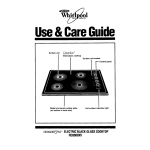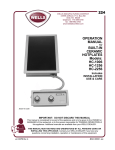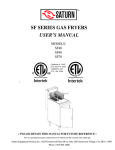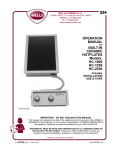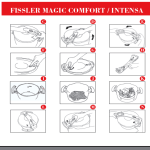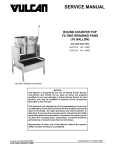Download Vulcan-Hart ML-114950 User's Manual
Transcript
INSTALLATION & OPERATION MANUAL ROUND GAS TILTING SKILLET MODEL VGTRS35 MODEL VGTRS35 VULCAN-HART FORM 31061 (4-98) ML-114950 COMPANY, P.O. BOX 696, LOUISVILLE, KY 40201-0696, TEL. (502) 778-2791 IMPORTANT FOR YOUR SAFETY THIS MANUAL HAS BEEN PREPARED FOR PERSONNEL QUALIFIED TO INSTALL GAS EQUIPMENT, WHO SHOULD PERFORM THE INITIAL FIELD START-UP AND ADJUSTMENTS OF THE EQUIPMENT COVERED BY THIS MANUAL. POST IN A PROMINENT LOCATION THE INSTRUCTIONS TO BE FOLLOWED IN THE EVENT THE SMELL OF GAS IS DETECTED. THIS INFORMATION CAN BE OBTAINED FROM THE LOCAL GAS SUPPLIER. IMPORTANT IN THE EVENT A GAS ODOR IS DETECTED, SHUT DOWN UNITS AT MAIN SHUTOFF VALVE AND CONTACT THE LOCAL GAS COMPANY OR GAS SUPPLIER FOR SERVICE. FOR YOUR SAFETY DO NOT STORE OR USE GASOLINE OR OTHER FLAMMABLE VAPORS OR LIQUIDS IN THE VICINITY OF THIS OR ANY OTHER APPLIANCE. WARNING IMPROPER INSTALLATION, ADJUSTMENT, ALTERATION, SERVICE OR MAINTENANCE CAN CAUSE PROPERTY DAMAGE, INJURY OR DEATH. READ THE INSTALLATION, OPERATING AND MAINTENANCE INSTRUCTIONS THOROUGHLY BEFORE INSTALLING OR SERVICING THIS EQUIPMENT. IN THE EVENT OF A POWER FAILURE, DO NOT ATTEMPT TO OPERATE THIS DEVICE. © VULCAN-HART COMPANY, 1998 —2— TABLE OF CONTENTS GENERAL. . . . . . . . . . . . . . . . . . . . . . . . . . . . . . . . . . . . . . . . . . . . . . . . . . . . . . . . . . . . . . . . . . . . . . . 4 INSTALLATION . . . . . . . . . . . . . . . . . . . . . . . . . . . . . . . . . . . . . . . . . . . . . . . . . . . . . . . . . . . . . . . . . . 4 Unpacking . . . . . . . . . . . . . . . . . . . . . . . . . . . . . . . . . . . . . . . . . . . . . . . . . . . . . . . . . . . . . . . . . 4 Location . . . . . . . . . . . . . . . . . . . . . . . . . . . . . . . . . . . . . . . . . . . . . . . . . . . . . . . . . . . . . . . . . . 4 Installation Codes and Standards . . . . . . . . . . . . . . . . . . . . . . . . . . . . . . . . . . . . . . . . . . . . . . 5 Leveling . . . . . . . . . . . . . . . . . . . . . . . . . . . . . . . . . . . . . . . . . . . . . . . . . . . . . . . . . . . . . . . . . . 5 Gas Connections . . . . . . . . . . . . . . . . . . . . . . . . . . . . . . . . . . . . . . . . . . . . . . . . . . . . . . . . . . . 6 Testing the Gas Supply System . . . . . . . . . . . . . . . . . . . . . . . . . . . . . . . . . . . . . . . . . . . . . . . 6 Flue Connections . . . . . . . . . . . . . . . . . . . . . . . . . . . . . . . . . . . . . . . . . . . . . . . . . . . . . . . . . . . 6 Electrical Connections . . . . . . . . . . . . . . . . . . . . . . . . . . . . . . . . . . . . . . . . . . . . . . . . . . . . . . . 7 Service Connections . . . . . . . . . . . . . . . . . . . . . . . . . . . . . . . . . . . . . . . . . . . . . . . . . . . . . . . . 7 OPERATION . . . . . . . . . . . . . . . . . . . . . . . . . . . . . . . . . . . . . . . . . . . . . . . . . . . . . . . . . . . . . . . . . . . . 8 Controls . . . . . . . . . . . . . . . . . . . . . . . . . . . . . . . . . . . . . . . . . . . . . . . . . . . . . . . . . . . . . . . . . . 8 Before First Use . . . . . . . . . . . . . . . . . . . . . . . . . . . . . . . . . . . . . . . . . . . . . . . . . . . . . . . . . . . . 8 Lighting the Tilting Skillet . . . . . . . . . . . . . . . . . . . . . . . . . . . . . . . . . . . . . . . . . . . . . . . . . . . . . 9 Using the Tilting Skillet . . . . . . . . . . . . . . . . . . . . . . . . . . . . . . . . . . . . . . . . . . . . . . . . . . . . . . 9 Cleaning . . . . . . . . . . . . . . . . . . . . . . . . . . . . . . . . . . . . . . . . . . . . . . . . . . . . . . . . . . . . . . . . . 10 MAINTENANCE . . . . . . . . . . . . . . . . . . . . . . . . . . . . . . . . . . . . . . . . . . . . . . . . . . . . . . . . . . . . . . . . . 11 Lubrication . . . . . . . . . . . . . . . . . . . . . . . . . . . . . . . . . . . . . . . . . . . . . . . . . . . . . . . . . . . . . . . 11 Vent . . . . . . . . . . . . . . . . . . . . . . . . . . . . . . . . . . . . . . . . . . . . . . . . . . . . . . . . . . . . . . . . . . . . . 11 Service and Parts Information . . . . . . . . . . . . . . . . . . . . . . . . . . . . . . . . . . . . . . . . . . . . . . . . 11 TROUBLESHOOTING . . . . . . . . . . . . . . . . . . . . . . . . . . . . . . . . . . . . . . . . . . . . . . . . . . . . . . . . . . . . 11 —3— Installation, Operation and Care of ROUND GAS TILTING SKILLET MODEL VGTRS35 PLEASE KEEP THIS MANUAL FOR FUTURE USE GENERAL Your Vulcan-Hart Round Tilting Skillet is a versatile piece of equipment. It allows you to stew, simmer, pan fry, braise, grill, or saute, and all with a very uniform heat pattern. Capacity of Model VGTRS35 is 35 gallons. Vulcan-Hart tilting skillets are produced with quality workmanship and material. Proper installation, usage and maintenance of your tilting skillet will result in many years of satisfactory performance. It is suggested that you thoroughly read this entire manual and carefully follow all of the instructions provided. INSTALLATION Before installing, verify that the gas and electrical service agrees with the specifications on the rating plate located on the right side panel as you face the machine. If the supply and equipment requirements do not agree, do not proceed with the installation. Contact your dealer or Vulcan-Hart Company immediately. UNPACKING This tilting skillet was inspected before leaving the factory. The transportation company assumes full responsibility for safe delivery upon acceptance of the shipment. Immediately after unpacking, check for possible shipping damage. If the tilting skillet is found to be damaged, save the packaging material and contact the carrier within 15 days of delivery. Carefully unpack tilting skillet and place in a work-accessible area as near to its final installed position as possible. LOCATION The equipment area must be kept free and clear of combustible substances. The skillet is intended for use on non-combustible floors. When installed, minimum clearance from combustible and non-combustible must be 3" (76 mm) at the sides and 6" (152 mm) at the rear. The installation must allow adequate clearances for servicing and proper operation. —4— The skillet must be installed so that the flow of combustion and ventilation air will not be obstructed. Adequate clearance for air openings into the combustion chamber must be provided. Make sure there is an adequate supply of air in the room to allow for that required for combustion of gas at the burners. Do not permit fans to blow directly at the skillet. Wherever possible, avoid open windows next to the skillet. Avoid wall-type fans which create air across currents within the room. INSTALLATION CODES AND STANDARDS The Vulcan tilting skillet must be installed in accordance with: In the United States of America: 1. State and local codes. 2. National Fuel Gas Code, ANSI-Z223.1 (latest edition). Copies may be obtained from The American Gas Association, Inc., 1515 Wilson Blvd., Arlington, VA 22209. 3. National Electrical Code, ANSI/NFPA-70 (latest edition). Copies may be obtained from The National Fire Protection Association, Batterymarch Park, Quincy, MA 02269. In Canada: 1. Local codes. 2. CAN/CGA-B149.1 Natural Gas Installation Code (latest edition). 3. CAN/CGA-B149.2 Propane Installation Code (latest edition), available from the Canadian Gas Association, 178 Rexdale Blvd., Etobicoke, Ontario, Canada M9W 1R3. 4. Canadian Electrical Code, CSA C22.2 No. 3 (latest edition). Copies may be obtained from The Canadian Standard Association, 178 Rexdale Blvd., Etobicoke, Ontario, Canada M9W 1R3. LEVELING AND ANCHORING TILTING SKILLET The tilting skillet must be anchored to the floor. 1. Place skillet in the installation position. 2. Place a carpenter's level on top of the skillet and turn the adjustable feet to level the skillet side to side and front to back. 3. Mark hole locations on the floor through the anchoring holes provided in the rear flanged adjustable feet. See diagram on page 7. 4. Remove skillet from installation position and drill holes in locations marked on the floor. Insert proper anchoring devices (not supplied). 5. Place skillet back in the installation position. —5— 6. Place carpenter's level on top of skillet and re-level side to side and front to back. 7. Bolt and anchor skillet securely to the floor. 8. Seal bolts and flanged feet with silicone or equivalent compound. GAS CONNECTIONS Gas supply connections and any pipe joint compound must be resistant to the action of propane gases. Location of the gas inlet is at the rear of the skillet. Codes require that a gas shutoff valve must be installed in the gas line ahead of the skillet. Connect gas supply. Make sure the pipes are 1⁄2" (12.7 mm) and are clean and free of obstructions. The skillet is equipped with fixed burner orifices which coincide with installation elevation. Natural gas pressure regulators are preset for 3" W.C. (Water Column)(.75 kPa); propane gas pressure regulators are preset for 10.5" W.C. (2.6 kPa). WARNING: PRIOR TO LIGHTING, CHECK ALL JOINTS IN THE GAS SUPPLY LINE FOR LEAKS. USE SOAP AND WATER SOLUTION. DO NOT USE AN OPEN FLAME. After piping has been checked for leaks, all piping receiving gas should be fully purged to remove air. TESTING THE GAS SUPPLY SYSTEM When gas supply pressure exceeds 1⁄2 psig (3.45 kPa), the skillet and its individual shutoff valve must be disconnected from the gas supply piping system. When gas supply pressure is 1⁄2 psig (3.45 kPa) or less, the skillet should be isolated from the gas supply system by closing its individual manual shutoff valve. FLUE CONNECTIONS DO NOT obstruct the flow of flue gases from the flue located on the rear of the skillet. It is recommended that the flue gases be ventilated to the outside of the building through a ventilation system installed by qualified personnel. From the termination of the flue to the filters of the hood venting system, a minimum clearance of 18" (46 cm) must be maintained. Information on the construction and installation of ventilating hoods may be obtained from the standard for "Vapor Removal from Cooking Equipment," NFPA No. 96 (latest edition), available from the National Fire Protection Association, Batterymarch Park, Quincy, MA 02269. —6— ELECTRICAL CONNECTIONS WARNING: ELECTRICAL AND GROUNDING CONNECTIONS MUST COMPLY WITH THE APPLICABLE PORTIONS OF THE NATIONAL ELECTRICAL CODE AND/OR OTHER LOCAL ELECTRICAL CODES. WARNING: APPLIANCES EQUIPPED WITH A FLEXIBLE ELECTRIC SUPPLY CORD ARE PROVIDED WITH A THREE-PRONG GROUNDING PLUG. IT IS IMPERATIVE THAT THIS PLUG BE CONNECTED INTO A PROPERLY GROUNDED THREE-PRONG RECEPTACLE. IF THE RECEPTACLE IS NOT THE PROPER GROUNDING TYPE, CONTACT AN ELECTRICIAN. DO NOT REMOVE THE GROUNDING PRONG FROM THIS PLUG. A 120/60/1 supply cord is supplied at the rear of the skillet. Do not connect the skillet to electrical supply until after gas connections have been made. The electrical diagram is located inside the skillet control box. SERVICE CONNECTIONS —7— OPERATION WARNING: THE TILTING SKILLET AND ITS PARTS ARE HOT. USE CARE WHEN OPERATING, CLEANING OR SERVICING THE TILTING SKILLET. CONTROLS (Fig. 1) POWER SWITCH TEMPERATURE LIGHT THERMOSTAT IGNITION LIGHT PL-41053-1 Fig. 1 Thermostat — Maintains set temperature by controlling power supply. Power Switch — Turns power to the skillet ON and OFF. Temp. Light — (Red) When lit, indicates the burners are supplying heat to the skillet. Light cycles ON and OFF as burner cycles on and off. Ignition Light — (Green) When lit, indicates ignition has occurred. Light will go out when set temperature is reached. Hand Wheel — (Not Shown.) Turn clockwise to tilt skillet; turn counterclockwise to return skillet to the upright position. BEFORE FIRST USE Clean the protective metal oils from all surfaces of the skillet. Use a non-corrosive, grease dissolving commercial cleaner, following manufacturer's directions. Rinse thoroughly and wipe dry with a soft clean cloth. Clean all accessories. Rinse thoroughly and wipe dry. —8— LIGHTING THE TILTING SKILLET 1. Open main gas valve. 2. Ensure skillet is in the UPRIGHT position. 3. Turn power switch ON. Set thermostat dial to desired setting. This will turn on the electronic ignition. The gas solenoid valve will open, supplying gas to the burner. The RED temperature light and the GREEN ignition light will come on. 4. If ignition is not achieved, turn the thermostat to OFF and turn the Power Switch to OFF. Wait 5 minutes before repeating steps 2 and 3. 5. When skillet reaches set temperature, the RED temperature light and the GREEN ignition light will go off and the burner will shut off. The burner will cycle on and off to maintain a set temperature. Shutdown Turn thermostat to OFF. Turn Power Switch to OFF. For extended shutdown, turn thermostat, power switch, and main gas valve OFF. USING THE TILTING SKILLET When the skillet is tilted, power supply to the burner is interrupted. The skillet can only be operated in the upright position. Do not tilt the skillet with the cover down. To prevent discoloration of stainless steel cooking surface, do not turn the heat on unless the skillet is covered with a fluid, a thin layer of cooking oil, or food to be cooked. 1. Tilt skillet to ensure that it moves easily. Turn handle as far as it will go and then return to upright position. 2. Turn the Power Switch ON. 3. Set the Thermostat dial to HIGH (#10). 4. Preheat skillet and allow it to cycle in order to equalize heat across the entire pan surface. 5. Set the Thermostat dial to the desired cooking temperature. Cooking will occur faster with the cover down. —9— The following are approximate temperature equivalents for the Thermostat dial settings: Approx. Temp. (°F) (°C) Setting 1-4 5-6 7-8 8-9 9 - 10 100 225 300 325 350 - 200 275 350 375 450 38 107 149 163 177 - 93 135 177 191 232 6. At the end of cooking, turn the Thermostat to OFF and turn the Power Switch to OFF. 7. Remove product. The skillet is provided with a stationary support for holding the food receiving pan when unloading prepared foods. The food receiving pan is removable for cleaning. CLEANING WARNING: DISCONNECT ELECTRICAL POWER SUPPLY BEFORE CLEANING. Do not use corrosive cleaning agents. After Each Use The tilting skillet should be cleaned after each use. Clean with warm water and a mild detergent. Rinse thoroughly and wipe dry with a soft clean cloth. Make sure that pour spout, strainer, cover, and sides of skillet are cleaned in the same manner. Remove the food receiving pan and clean it in a sink as you would any utensil. Once A Day Thoroughly clean the skillet with warm water and a mild detergent. Rinse thoroughly and wipe dry with a soft clean cloth. Stainless Steel Clean stainless steel surfaces with a damp cloth and polish with a soft dry cloth. To remove discolorations, use a non-abrasive cleaner. — 10 — MAINTENANCE WARNING: THE TILTING SKILLET AND ITS PARTS ARE HOT. USE CARE WHEN OPERATING, CLEANING OR SERVICING THE TILTING SKILLET. WARNING: UNPLUG ELECTRICAL POWER SUPPLY. LUBRICATION Never grease or oil the pivot bearings as this may cause problems with tilting. Bearings are oilite and never require lubrication. VENT Annually, when the tilting skillet is cool, check the flue and clear any obstructions. SERVICE AND PARTS INFORMATION To obtain service and parts information concerning this tilting skillet, contact the Vulcan-Hart Service Agency in your area (refer to listing supplied with the skillet), or Vulcan-Hart Company Service Department at the address or phone number shown on the front cover of this manual. TROUBLESHOOTING PROBLEM POSSIBLE CAUSES Burner does not come on. 1. 2. 3. 4. Skillet difficult to tilt. Dirt in oilite bearings causing it to bind. Contact your local Vulcan-Hart authorized servicer. — 11 — Gas supply to skillet is not on. Manual shut-off valve is off. Thermostat is not turned on. The pan is not in the lowest position. NOTES FORM 31061 (4-98) — 12 — PRINTED IN U.S.A














